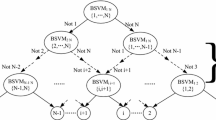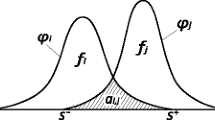Abstract
To improve the diagnosis accuracy of analog circuit, this paper presents a second map support vector data description (SM-SVDD) method, which uses an anomalous and close surface instead of a hypesphere to describe the target data. The fault classifier is constructed by a SM SVDD algorithm to realize analog circuit fault diagnosis. Experimental results on two typical circuits confirm that the proposed method is effective in analog circuit fault diagnosis with good accuracy, and the performance surpasses other intelligent diagnosis methods, such as back propagation neural network, support vector machine and the normal SVDD. The developed method can be applied to other multi-classifier in electronic applications.







Similar content being viewed by others
References
Sarathi Vasan, A. S., Bing, L., & Pecht, M. (2013). Diagnostics and prognostics method for analog electronic circuits. IEEE Transactions on Industrial Electronics, 60(11), 5277–5291.
Luo, H., Wang, Y., & Cui, J. (2011). A SVDD approach of fuzzy classification for analog circuit fault diagnosis with FWT as preprocessor. Expert Systems with Applications, 38(8), 10554–10561.
Zhang, C., He, Y., Yuan, L., et al. (2014). A novel approach for analog circuit fault prognostics based on improved RVM. Journal of Electronic Testing, 30(3), 343–356.
Jahangiri, M., & Razaghian, F. (2014). Fault detection in analogue circuits using hybrid evolutionary algorithm and neural network. Analog Integrated Circuits and Signal Processing, 80(3SI), 551–556.
Xiao, Y. Q., & Feng, L. G. (2012). A novel neural-network approach of analog fault diagnosis based on kernel discriminant analysis and particle swarm optimization. Applied Soft Computing, 12(2), 904–920.
Tan, Y., He, Y., Cui, C., & Qiu, G. (2008). A novel method for analog fault diagnosis based on neural networks and genetic algorithms. IEEE Transactions on Instrumentation and Measurement, 57(11), 2631–2639.
Stopjaková, V., Malošek, P., Mičušík, D., Matej, M., & Margala, M. (2004). Classification of defective analog integrated circuits using artificial neural networks. Journal of Electronic Testing, 20(1), 25–27.
Long, B., Xian, W. M., Li, M., et al. (2014). Improved diagnostics for the incipient faults in analog circuits using LSSVM based on PSO algorithm with Mahalanobis distance. Neurocomputing, 133(10), 237–248.
Zhang, Z., Duan, Z. M., Long, Y., et al. (2014). A new swarm-SVM-based fault diagnosis approach for switched current circuit by using kurtosis and entropy as a preprocessor. Analog Integrated Circuits and Signal Processing, 81(1SI), 289–297.
Ni, J., Zhang, C., & Yang, S. X. (2011). An adaptive approach based on KPCA and SVM for real-time fault diagnosis of HVCBs. IEEE Transactions on Power Delivery, 26(3), 1960–1971.
Vapnik, V. N. (1998). Statistical learning theory. New York: Wiley.
Tax, D. M. J., & Duin, R. P. W. (2004). Support vector data description. Machine Learning, 54(1), 45–66.
Sakla, W., Chan, A., Ji, J., & Sakla, A. (2011). An SVDD-based algorithm for target detection in hyperspectral imagery. IEEE Geoscience and Remote Sensing Letters, 8(2), 384–388.
Ben Khediri, I., Weihs, C., & Limam, M. (2012). Kernel k-means clustering based local support vector domain description fault detection of multimodal processes. Expert Systems with Applications, 39(2), 2166–2171.
Guo, S. M., Chen, L. C., & Tsai, J. (2009). A boundary method for outlier detection based on support vector domain description. Pattern Recognition, 42(1), 77–83.
Zhao, Y., Wang, S. W., & Xiao, F. (2013). Pattern recognition-based chillers fault detection method using Support Vector Data Description (SVDD). Applied Energy, 112(SI), 1041–1048.
Zhang, Y., Liu, X. D., & Xie, F. D. (2009). Fault classifier of rotating machinery based on weighted support vector data description. Expert Systems with Applications, 36(4), 7928–7932.
Lee, K., Kim, D. W., Lee, K. H., et al. (2007). Density-induced support vector data description. IEEE Transaction on Neural Networks, 18(1), 284–289.
Liu, S. Y., Liang, J. J., Wu, D., et al. (2009). Confidence support vector domain description. Journal of Systems Engineering and Electronics, 20(4), 852–857.
Sjostrand, K., Hansen, M. S., Larsson, H. B., et al. (2007). A path algorithm for the support vector domain description and its application to medical imaging. Medical Image Analysis, 11(5), 417–428.
Akbay, S.S., Chatterjee, A. (2007). Fault-based alternate test of RF components. In: 25th International Conference on Computer Design (pp. 518–525).
Nathan, K., Petros, D., Mustapha, S., et al. (2009). On boosting the accuracy of non-RF to RF correlation-based specification test compaction. Journal of Electronic Testing, 25(6), 309–321.
Tavakkoli, A., Nicolescu, M., Bebis, G., et al. (2008). Incremental SVDD training: Improving efficiency of background modeling in videos. In: Proceedings of the IASTED Signal and Image Processing Conference.
Khazai, S., Safari, A., Mojaradi, B., et al. (2012). Improving the SVDD approach to hyperspectral image classification. IEEE Geoscience and Remote Sensing Letters, 9(4), 594–598.
Liu, Y. H., Liu, Y. C., & Chen, Y. J. (2010). Fast support vector data descriptions for novelty detection. IEEE Transactions on Neural Networks, 21(8), 1296–1313.
Jordi, M. M., Lorenzo, B., & Gustavo, C. V. (2007). A support vector domain description approach to supervised classification of remote sensing images. IEEE Transactions on Geoscience and Remote Sensing, 45(8), 2683–2692.
Banerjee, A., Burlina, P., & Diehl, C. (2006). A support vector method for anomaly detection in hyperspectral imagery. IEEE Transactions on Geoscience and Remote Sensing, 44(8), 2282–2291.
Lee, D., & Lee, J. (2007). Domain described support vector classifier for multi-classification problems. Pattern Recognition, 40(1), 41–51.
Kang, W. S., & Choi, J. Y. (2008). Domain density description for multiclass pattern classification with reduced computational load. Pattern Recognition, 41(6), 1997–2009.
Wang, J., Neskovic, P., & Cooper, L. N. (2007). Bayes classification based on minimum bounding spheres. Neurocomputing, 70(4), 801–808.
Mu, T. T., & Nandi, A. K. (2009). Multiclass classification based on extended support vector data description. IEEE Transactions on Systems, Man, and Cybernetics-Part B: Cybernetics, 39(5), 1206–1216.
Zhu, M. L., Wang, Y., Chen, S. F. (2003). Sphere-structured support vector machines for multi-class pattern recognition. In: 9th International conference on Rough sets, fuzzy sets, data mining, and granular computing (pp. 589–593).
Zhuang, J., Luo, J., Peng, Y., Wu, C. (2008). On-line fault detection method based on modified SVDD for industrial process system. In 3rd International Conference on Intelligent System and Knowledge Engineering (pp. 754–760).
Fawcett, T. (2006). An introduction to ROC analysis. Pattern Recognition Letters, 27(8), 861–874.
Wang, R., Tang, K. (2009) Feature selection for maximizing the area under the ROC curve. In: IEEE International Conference on Data Mining Workshops (pp. 400–405).
Cui, J., & Wang, Y. (2011). A novel approach of analog circuit fault diagnosis using support vector machines classifier. Measurement, 44(1), 281–289.
Lingras, P., & Butz, C. (2007). Rough set based 1-v-1 and 1-v-r approaches to support vector machine multi-classification. Information Sciences, 177(18), 3782–3798.
Cui, J., & Wang, Y. (2011). Analog circuit fault classification using improved one-against-one support vector machines. Metrology and Measurement Systems, XVIII, 4, 569–582.
Acknowledgments
This work is supported by National Natural Science Foundation of China (No. 61371041), National Natural Science Foundation of China (No. 61401215), Aviation Science Foundation of China (No. 2013ZD52055), Fundamental Research Funds for the Central Universities and Funding of Jiangsu Innovation Program for Graduate Education (No. CXLX11_0183).
Author information
Authors and Affiliations
Corresponding author
Rights and permissions
About this article
Cite this article
Jiang, Y., Wang, Y. & Luo, H. Fault diagnosis of analog circuit based on a second map SVDD. Analog Integr Circ Sig Process 85, 395–404 (2015). https://doi.org/10.1007/s10470-015-0597-9
Received:
Revised:
Accepted:
Published:
Issue Date:
DOI: https://doi.org/10.1007/s10470-015-0597-9




